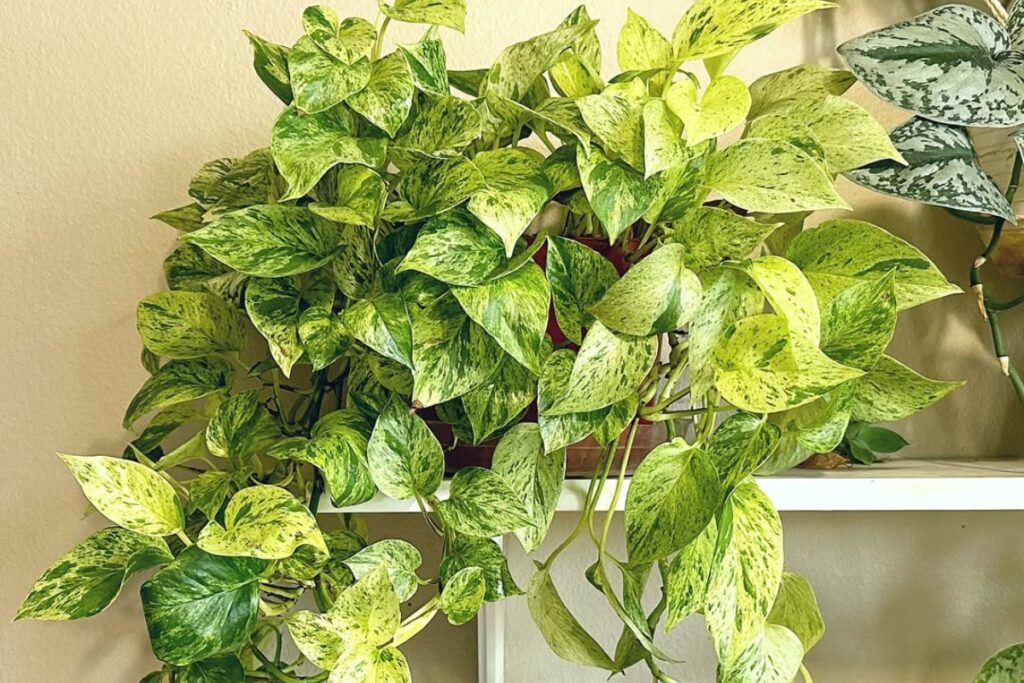You’ll probably spend more time admiring your Marble Queen’s stunning variegated leaves than actually caring for it, which is exactly how plant parenthood should work. This gorgeous pothos variety demands just enough attention to keep things interesting, but won’t turn into a high-maintenance drama queen. The secret lies in understanding its specific quirks, from light preferences to watering rhythms. Master these fundamentals, and you’ll discover why experienced plant enthusiasts consider this their most rewarding companion.

Contents
Understanding Your Marble Queen Pothos
Few houseplants offer the perfect blend of stunning beauty and foolproof care quite like the Marble Queen Pothos. You’ll immediately recognize its distinctive heart-shaped leaves featuring creamy white and green variegation patterns. This trailing vine belongs to the Epipremnum aureum family, originally from French Polynesia’s tropical forests.
Understanding its leaf structure helps you provide better care. The white sections lack chlorophyll, making them depend on green areas for photosynthesis. You’ll notice cascading growth patterns that can stretch several feet when happy. These vines naturally climb or trail, adapting to whatever support you provide in your home.
Creating the Perfect Growing Environment
Three key environmental factors determine whether your Marble Queen thrives or merely survives: light, temperature, and humidity. Position yours near bright, indirect light—those gorgeous white patches lack chlorophyll, so adequate lighting prevents reversion to plain green. East-facing windows work perfectly for gentle morning sun.
Maintain temperatures between 65-85°F, avoiding anything below 50°F. Your plant’s tropical origins demand humidity levels above 40%, though 60% is ideal. Boost moisture with pebble trays, grouping plants, or humidifiers.
Don’t overlook soil composition—use well-draining houseplant mix with perlite and coconut coir for proper drainage.

Watering and Fertilizing Best Practices
With your growing environment dialed in, mastering the watering schedule becomes your next priority for healthy growth. Check soil moisture by inserting your finger two inches deep—water when dry but before the entire pot dries out. Your watering frequency should be every 7-10 days during spring and summer, extending to 2-3 weeks in winter.
For fertilizer types, choose balanced liquid fertilizers with equal NPK ratios. Dilute according to package instructions and apply during regular watering sessions. Alternatively, convenient slow-release fertilizer sticks work well when buried directly in soil for steady nutrient delivery.
Maintaining Optimal Light and Temperature Conditions
Where should you place your Marble Queen to achieve that stunning variegation everyone raves about? Light placement matters more than you think. Position yours near an east-facing window for gentle morning sun, or choose bright indirect light throughout the day. Those gorgeous white patches can’t photosynthesize, so they need extra help from green areas.
Temperature fluctuations can stress your plant, so maintain 65-85°F consistently. Avoid cold drafts, heating vents, and anywhere below 50°F. Your Marble Queen will reward proper conditions with vibrant variegation and healthy growth patterns you’ll love.
Troubleshooting Common Issues and Pest Management
Although Marble Queens are relatively low-maintenance plants, they can still encounter problems that’ll frustrate even experienced plant parents. Leaf discoloration typically signals watering issues—yellow leaves mean you’re overwatering, while brown, crispy edges indicate underwatering or low humidity. Loss of variegation occurs when light’s insufficient; move your plant closer to bright, indirect light.
For pest identification, watch for spider mites’ tiny webs, aphids clustering on new growth, and mealybugs’ white, cottony masses. Apply neem oil every week until pests disappear. Fungus gnats hover around soil, indicating overwatering—reduce watering frequency and use sticky traps for immediate relief.
Pruning and Long-term Plant Health Strategies
Since Marble Queens naturally grow as climbing vines in their native habitat, regular pruning keeps them looking full and prevents them from becoming leggy. You’ll want to trim vines above leaf nodes using clean scissors, which encourages new growth at those points. These pruning techniques work best during spring and summer when your plant’s actively growing.
Never remove more than one-third of your plant at once, as this can stress it. Strategic cuts actually promote growth stimulation, creating bushier, more attractive foliage. Wipe your cutting tools with rubbing alcohol between plants to prevent spreading diseases or pests.
